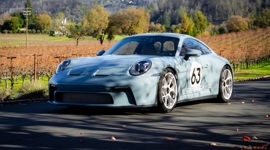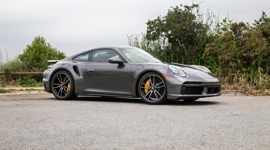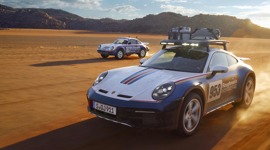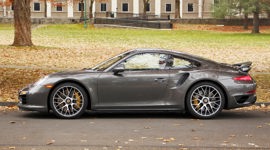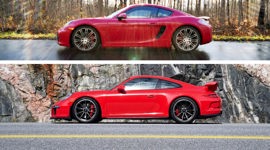 AutoTrader SCORE
AutoTrader SCORE
-
STYLING9/10
-
Safety6/10
-
PRACTICALITY6/10
-
USER-FRIENDLINESS6/10
-
FEATURES7/10
-
POWER9/10
-
COMFORT7/10
-
DRIVING FEEL10/10
-
FUEL ECONOMY6/10
-
VALUE7/10
Despite weather better-suited for mid-November than May, not a peep of complaint crossed my lips while testing the 2021 Porsche 911 Targa 4S.
Porsche has never shied from the idea that the 911 is fully capable of all-weather use, and this newest semi-convertible is no exception, proving throughout the week that regardless of the weather (or the destination) this is a car meant to add joy to the chore of driving.
Styling: 9.5/10
Having been in production since 1963 and with more than a million units sold, the 911 is one of the world’s most iconic automotive shapes. The Targa format has been around almost as long, with Porsche having patented the concept in 1965 as a means to balance the wants of open-top motorists with the safety needs demanded by regulators. And while the B-pillar/roll hoop was originally a support for a fold-down plastic window, the large, rounded glass affair seen here is nearly as iconic as the 911’s teardrop profile.
For a few unfortunate generations (993, 996, 997) the Targa offered nothing more than an oversized glass sunroof that would slide back into the rear glass area, and, frankly, it did nothing for the car’s appearance. Then, in 2014 for the 991 generation, Porsche returned to form by offering a traditional silver roll bar and wrap-around rear glass. In this 992 version, it’s a perfect blend of what the contemporary 911 has become (larger, lower, wider), with a delightful nod to its storied past.
The proportions are brilliant and I found my eye repeatedly drawn to the Targa script badge on the roll bar, reminding me that this is a work of historic automotive art. It could only be a 911, but should there be any doubt from onlookers, the large “PORSCHE” script in gold along the lower flanks will help clear things up.
Inside, the Targa continues the blend of past with present, offering the largely digital displays motorists demand to manage all the technology on offer, with the five-dial gauge display being a subtle nod to the way 911s have always been. The black and tan contrast nicely, and build quality is exceptional – though not all of the materials feel as lavish as one might expect in such a costly car.
Power: 9/10
Traditionalists that they are working at Porsche, they’ve stuck with a horizontally opposed six-cylinder engine throughout the 911’s heritage. Displacing 3.0L, all 911 engines are now turbocharged (not just the 911 Turbo), and the result in the 4S is 443 hp and 390 lb-ft of torque. Had this car been fitted with an automatic transmission and the Sport Chrono package, it would be able to hit 100 km/h from a standstill in a claimed 3.6 seconds. While armchair racers will bemoan the fact that my test car can only achieve the same feat in 4.4 seconds due to its manual transmission, I can assure you that there were no hard feelings here.
The seven-speed manual transmission is a no-cost option, and while the fact that it’s still offered should be enough motivation these days to order it, in the 911, it’s an absolute no-brainer. Those interested in the quickest or most track-worthy 911s will look to a lighter coupe anyway – or, better yet, a GT3 – instead of the comparatively portly Targa that weighs in at 1,640 kg (3,616 lb), but whining over a few tenths of a second in acceleration lost to the joy of shifting your own gears is pointless.
The power delivery is so smooth and linear that even if you find yourself in too tall a gear, the engine is so tractable that decent acceleration is possible even from loafing engine speeds. But there’s no excuse to ever be caught short since the drivetrain is such a willing partner, wanting the driver to exercise it repeatedly, resulting in ever-present and exceptional thrust.
Driving Feel: 10/10
The centre console rises to meet the dashboard, placing the shifter quite high and making it easy to snatch a gear and get your hands back on the wheel, just as you’d want on a track. The throws are short, the gate well-defined, and concerns of getting lost rowing through seven slots are immediately dispersed as the shifter seems to know telepathically where it needs to go.
Shift action is a big part of making a good manual transmission experience, but clutch feel and pedal placement are also crucial, and here again the 911 excels. The clutch is just heavy enough to not feel flimsy or aloof, but not so stiff to regret purchasing a stick shift when sitting in traffic. The footwell skews slightly toward the right, but pedal placement is excellent keeping feet dancing on all three during a spirited drive. Drivers who don’t want to perfect their heel-and-toe technique can still look (and sound) like aces with the automated rev-matching in sport mode.
Fears of snap-oversteer from 911s of days long ago couldn’t be further from mind when hustling the 4S around curvy country roads. The composure of the suspension and the grip of the monstrous Goodyear Eagle F1 tires make the Targa’s capabilities so high that they should really only be approached on a track. But where so many modern high-performance cars can achieve otherworldly handling, they do so with so little feedback or drama that it’s almost like the driver is a bystander in the process. Not so here, where the Porsche’s steering still offers ample feedback and it’s quick enough that even subtle inputs result in immediate reactions. And should a driver need to shed speed in a big hurry, the Targa’s brakes offer ferocious stopping power, and a firm, linear pedal feel.
Comfort: 7/10
When parked next to older air-cooled 911s, this 992 generation looks immense, and yet despite the growth, it’s still an incredibly engaging car to drive. But, thanks to the adaptive suspension and various drive modes, it remains possible to make the Targa 4S a decent boulevard cruiser, or road trip warrior. The 18-way adaptive sport seats can be manipulated to suit drivers’ shapes and sizes, and they’re both heated and cooled here.
Practicality: 6/10
By supercar standards, the 911 is and has been the most sensible machine in the category, refined and capable enough to be used as a daily driver to the office or ski lodge, or to rip off sizzling laps at a track. These days, even crossover SUVs and electric vehicles like those in Porsche’s own showroom can be made to go exceptionally fast but are better-suited to family- or client-hauling duties. The Targa only comes with all-wheel drive, and brands make winter tires that’ll fit, so it can still offer all-weather transport.
Like all but the raciest of 911s, the Targa has a backseat (replete with LATCH child seat anchors), and while I did manage to climb back there, headroom is not suitable for anyone taller than munchkin-size. The frunk in the 911’s nose will contain 130 L of cargo, which should be enough to swallow a medium-sized suitcase and a secondary duffle bag, but not much else. Best to fold down the rear seats and stow a few more bags there if you’re travelling with a heavy packer.
User Friendliness: 6/10
While the 911 isn’t as exotic or low-slung as some of its competitors, it can still be a challenge to drop down into the driver’s seat for those who aren’t as limber as they once were. Once inside, however, headroom is decent and the outward visibility is very good – owing to the giant greenhouse of glass surrounding the cockpit.
The driving position suited me perfectly with every key driver touchpoint falling exactly to hand as if it had been designed just for me. There are ergonomic quirks with the 911, though. The infotainment system requires a fair amount of time to learn, and while its touchscreen is bright and crisp, having a few key redundancy buttons nearby for quick access to key functions wouldn’t be unwelcome. It’s not an overly intuitive system and it was prone to a few glitches especially when CarPlay was connected wirelessly.
The steering wheel feels great in hand, but it’s lacking some of the controls drivers have come to expect. It’s possible to skip an audio track forward, for instance, but not back. And while I give Porsche credit for sticking to tradition with the five-gauge display, no matter how I adjusted my seat and the steering wheel the two outer gauges were completely obscured.
Features: 7/10
With $30,000 in options added to this Targa, you’d think it would be chock-full of luxury accoutrements, but that’s not entirely the case. Sure there’s a $1,440 interior leather package, but large spans of the dashboard were simply plastic. More leather is available, but it costs more.
The optional sound system offers a bright, clear sound stage, but open-top cars – especially ones with optional sport exhaust systems – aren’t the best places for audiophiles anyway. Being a stick-shift means adaptive cruise control isn’t offered here, either.
It is possible to configure a Targa 4S to suit almost any buyer’s whims thanks to a nearly infinite number of ways to option-up, customize, or accessorize right on Porsche’s online configurator. The most significant features of this car include its driving enjoyment, and elaborate, electrically operated roof panel that stows quickly at the touch of a single button.
Fuel Economy: 6/10
Cars with the performance of the Targa 4S aren’t typically paragons of efficiency, and while the 12.1 L/100 km average observed during my test week is nothing to write home about, it should be noted that as much of that test time as possible was spent enjoying the sonorous six-cylinder revving up, over and over again. A lighter throttle foot could net something closer to the official highway rating of 9.8 L/100 km, and a very decent range from the 67-L fuel tank. Around town, the Targa 4S is rated at 13.7, and combined, 11.9 L/100 km, and of course the Porsche requires premium-grade gas in the tank.
Safety: 6/10
The Targa 4S, like all current 911s, offers exceptional performance capabilities, offering drivers a very fast, but very capable car with tremendous handling and braking. Still, it’s meant to be a driver’s car, and as such, many of the active safety functions found on most new cars are not found here. There’s a lane-change assist, but no dynamic brake support, forward collision warning, or imminent crash braking. Otherwise, Porsche includes the essentials, such as a strong structure and the required airbags.
Value: 7/10
Starting at $156,100, the Targa 4S costs the same as a 911 Carrera 4S Cabriolet, making them the two most expensive Carrera models beneath the 911 Turbo line up. It’s possible to get a new 911 for $70,000 less than this Targa 4S, or a hundred grand more. Porsche allows a buyer to build the car specific to their whims based solely on how much they want to spend. Where the Targa 4S’s real value stems is a level of driver engagement that’s nearly extinct these days. That a buyer also gets the style, build quality, and cachet of the storied 911 Targa only helps justify the six-figure spend further.
The Verdict
While daily mundane chores were made substantially better simply because I was able to do them in the 2021 Porsche 911 Targa 4S, it’s a car that’s so much more than just a fun performance machine. It’s comfortable, well-built, and rewards a driver’s involvement in a way that remarkably few cars do, and that applies even during dismal weather. But when the sun is shining and that roof panel is stowed, driving the 911 Targa 4S is just about as close as one can get to pure automotive nirvana.
| Engine Displacement | 3.0L |
|---|---|
| Engine Cylinders | Turbo H6 |
| Peak Horsepower | 443 hp @ 6,500 rpm |
| Peak Torque | 390 lb-ft @ 2,300–5,000 rpm |
| Fuel Economy | 13.7 / 9.8 / 11.9 L/100 km cty/hwy/cmb |
| Cargo Space | 130 L |
| Model Tested | 2021 Porsche 911 Targa 4S |
| Base Price | $156,100 |
| A/C Tax | $100 |
| Destination Fee | $1,500 |
| Price as Tested | $185,705 |
|
Optional Equipment
$30,005 – Night Blue Metallic paint, $950; Premium Package, $6,100; LED-Matrix Design Headlights in black, $3,130; Burmester sound system, $4,540; Targa Roll Bar in satin black, $790; Logo courtesy lights, $190; Side Decals, $590; PORSCHE logo in gloss black, $340; Model Designation in Exterior Colour, $365; Sport Exhaust, $3,370; Rear Axle Steering, $2,390; Wheels in Satin Aurum, $1,480; Adaptive Sport Seats (18-way) with memory, $3,960; Heated GT Sport Steering wheel, $370; Interior Trim package in leather, $1,440
|
|


















































